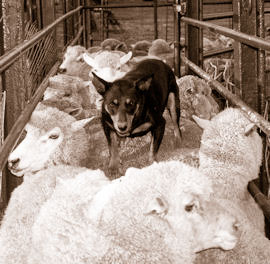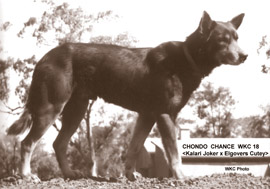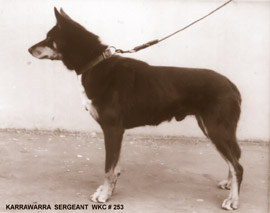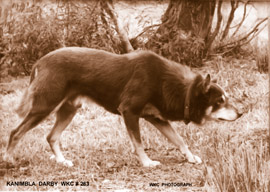

Introduction
Historically, as soon as any new Breed is evolved its acceptance as such creates an association between the work it has been bred toS perform and a certain overall appearance. Sooner or later a written standard or description is drawn up to present a word picture of a mythical super animal towards which the breeder strives to produce. Taken overall, certain disciplines in selection and rejection are set down which are, or should be, designed for the betterment of the breed in question.
Written Descriptions
The first standard for the Kelpie was drawn up just after the turn of the century setting down conformation requirements, which remain valid today. Over the years the original standard has been subject to amendment and addition by the Canine bodies responsible for the conduct of Dog Shows.
Most of alterations have related to superficial qualities such as coat colour, texture, length etc. etc. The different appearance of Show Kelpies today has been caused, in my opinion, mainly by a lack correct interpretation of structural requirements and a practical knowledge of stock work and pastoral conditions.
The production of a written description of breed type requirements for Working Kelpies stems from the need to place prime importance on the dog's ability to perform efficiently and to remove the emphasis on the unrelated and unsuitable qualities set down in the standard adopted by the Australian National Kennel Control and which is used as a guide by breeders of Show Kelpies.

The drawing up of guidelines to describe desirable Working Kelpie conformation and breed characteristics is not designed to encourage selection of dogs which comply with a written interpretation to the exclusion of natural working ability which must always remain the most important aspect of consideration by genuine breeders of Working Kelpies.
It must be stressed that the purpose behind this work is to generate interest in the production of dogs which are excellent workers, possess sound conformation and identifiable breed type, and not to suggest that any changes should be made unless the dog is ‘off type’ and unable to perform as efficiently as one would expect.
Quite a number of factors, which cannot be adequately covered in a guide of this nature, are responsible for the efficiency or lack of it, and they are in many ways interacting. One can get the near perfectly made dog which has not got the stamina to perform his work as efficiently or as quickly as his conformation suggests.
If, for instance, his heart is not sufficiently strong in its action to meet the demands of extended periods of exertion, or if there is restriction in the arteries, he will not be able to make the best of his inherited good ‘type’. If the dog's diet is inadequate, or he is suffering from the effects of internal parasites, or is not in reasonable hard muscular condition, his performance will also be affected. For ultimate results the dog needs to possess a strongly inherited desire to work and basically sound conformation coupled with general good health and recognisable Kelpie breed type.
Breed type and conformation should not be confused or lumped together. It is easy to place too much importance on ‘type’; the word type in this case being used to describe general appearance. So you get an owner saying ‘Old so and so are not a good type but worth all the others put together’. ‘Old so and so’ may well be superior because his conformation or skeleton and natural working ability are closer to the ideal. The fact that his ears are half up, or he has a white streak on his face, white feet or that his coat is scraggy and so on, has nothing to do with his conformation.
Such things are on the surface and whilst they may not please the eye they do not affect ability Conformation is the way the frame is proportioned and put together; what covers it will not affect efficiency to any real extent. No dog is truly perfect and no one fault could be exampled as the cause of inefficiency. A bad shoulder is not seen on an otherwise perfect dog; the fact that the shoulder is wrong will affect the other parts to varying degree.
The ability to move silently smoothly and without obvious effort is governed by conformation. The effects of the noise (and vibrations) caused by the pounding of a heavy running dog will not be noticed on quiet sheep well accustomed to men, dogs and noise. It is on the wild ‘western’ sheep that this fault will be noticed. Similarly bad-footed dogs will not be handicapped working on soft improved areas where distance is strictly limited; it is on the hard dry holdings that this defect will quickly become obvious.
It is better from a Breed point of view that selection is made for qualities which suit the hardest conditions irrespective of what sort of environment the dogs are being used under.
Selection for the best working qualities and a thorough understanding of proper conformation will contribute more to the future of the Breed than will ever be made by a selection for superficial things like size of ears, coat quality, colour and so on.
For the very best of reasons, breeders of working dogs should concern themselves with the basic structural requirements fixed, over generations, by the physical demands of his work. If a breeder deviates more than slightly from these requirements he may find himself producing dogs which are physically unsuitable the job for which he bred them.

Once established as a distinct breed the animals automatically acquire 'breed type' and the drawing up of a set of guidelines to cover the overall appearance and characteristics is in many ways desirable, provided they are used as a guide secondary to the Kelpies' inherited ability to efficiently work stock.
Using the generally accepted format the breed characteristics, overall appearance, and conformation of our Working Kelpies could be described in the following way.
Characteristics
The Working Kelpie is or should be extremely alert, eager and highly intelligent. Possess an open friendly, active but placid disposition with a good balance between keenness to work and ability to relax. Display an almost inexhaustible energy; a marked loyalty and devotion to 'work' and a strongly inherited natural instinct and aptitude in the working of sheep, (and other livestock) both in open country and in the yards.
Comment - Bad temperament, high excitability, nervousness or aggressiveness are uncharacteristic and should be considered undesirable.
General Appearance
The overall appearance of the Working Kelpie should be that of a medium sized, lithe, active, strongly muscled dog possessing great suppleness of limb, and conveying the capability of untiring work.
Comment - Because of the relationship between body construction and movement it is essential that the Kelpie be structurally sound. It should be emphasised that the above be considered as a whole with particular attention to structural features related to movement and action, which should be smooth and effortless, with a good length of stride. Any structural faults affecting efficiency or constitution are highly undesirable.
Movement
During movement the gait should be free, smooth, and effortless with a good length of stride, showing a tendency for foot placement to move towards 'single tracking' just before breaking into a trot, and becoming more pronounced as speed increases.
There must be ability to turn suddenly at speed, and be capable of the crouching stealthy movement demanded by its work. When walking slowly (and when standing still) the legs seen from front or rear should be 'four square.' Comment - Because of the association with loss of efficiency any tendency to heavy 'pounding' gait, 'stiltedness', loose shoulders or restricted movement; weaving or plaiting gait should be considered highly undesirable.
Head
An acceptable Kelpie type head has a slightly rounded skull, broad between well-pricked ears, forehead curved very slightly towards a pronounced stop. The cheeks neither coarse nor prominent but rounded to the fore face, cleanly chiselled and defined. The muzzle, of moderate length tapered towards the nose and refined in comparison to the skull; lips tight and clean.
Comment - Too much emphasis should not be placed on the finer points of the head.
Teeth
Teeth should be sound, strong and evenly spaced. The lower incisors just behind but touching the upper.

Comment - Undershot, overshot or abnormal numbers of teeth are undesirable.
Eyes
The overall placement in the skull should provide the widest possible field of vision without the need of head movement with the eyes slightly oval shaped, of medium size and widely spaced, clearly defined at the corners and showing a kind, intelligent and eager expression.
Comment -From the 'pleasing appearance' point of view the colour of the eye should harmonise with the coat colour. Too much emphasis should not be placed on eye colour with preference given to placement. Small eyes particularly, if badly placed, should be considered undesirable.
Ears
Ears should be widely spaced, pricked and running to a fine point at the tip, the leather fine but strong at the base, inclining outwards and slightly curved on the outer edge and of moderate size; the inside of the ears well furnished with hair to discourage entry of foreign bodies. Comment There should be a marked ability to rotate the ear to catch sound to minimise head movement.
Neck
The neck should be of fair length, strong, slightly arched and showing quality, gradually moulding into the shoulders. Comment - Incorrect attachment at head or shoulder; short thick ‘bull’ or ‘ewe’ neck are undesirable structural faults.
Forequarters
As a whole should be clean, muscular with sloping shoulders close-set at the withers; elbows set parallel with the body. The forelegs should be muscular with strong but refined bone, perfectly straight when viewed from the front, but pasterns should show a slight angulation to the forearm when viewed from the side.
Shoulders
The shoulders should be clean, muscular, with a long sloping shoulder blade (scapula) set at approximately 45 degree angle to the ground; close-set withers, upper arm (humerus) forming a near 90 degree angle with the blade (scapula) and appropriately angulated to the forearm (radius and ulna) with elbows set parallel to the body. Particular emphasis should be placed on the sloping shoulder.
Comment - Two main faults to avoid are shoulders set too far forward and straight (upright) shoulders, both of which affect balance and inhibit free movement and should be considered serious faults.
Forelegs
Clean, muscular, refined boned and perfectly straight when viewed from the front. The length of leg should be approximately the same from the point of elbow (tip of the ulna) to the ground as is the distance from the wither to the base of the rib cage, with preference towards longer rather than shorter forelegs. The pastern should show a slight angle with the forearm when viewed from side.

Comment - Short forelegs and straight pastern (viewed from the side); Feet toed in or out (viewed from the front) should be considered undesirable.
Comment - Close knitting of toes should not be exaggerated.
Body
The chest should be deep, rather than wide; ribs well sprung (not barrel-ribbed) with a top line showing a rise at the withers (to allow sufficient action of the forequarters); strong and well muscled loins, sloping to the butt of the tail.
Comment - Any tendency to a 'level top line' is undesirable.
Length to Height Ratio 10-9
The body measured from the point of the breast bone in a straight line to the buttocks should be greater than the height at the withers, as 10 units is to 9 units. e g a dog 18 inches in height should measure 20 inches in length.
Comment- It is better for the dog to be too long than too short. Any tendency to squareness in a working dog is undesirable.
Chest
The chest when viewed from the side should be deep; the point of breast bone showing ahead of the junction between shoulder blade (scapula) and upper arm (humerus). The bottom line of the rib cage should curve downwards from its point, to below and slightly in front of the elbow (tip of the ulna) then remain level to the eighth rib before continuing in a gradual upwards curve towards the flank.
Comment - Because of the affect on heart and lung room any structural deviations in this area should be considered highly undesirable.
Hindquarters
Should show breadth and strength with the rump rather long and sloping; the upper thigh (femur) well set into the hip socket at the pelvis at a corresponding angle to the shoulder blade. When viewed from the side the overall upper line of rump and tail should form a smooth curve when the dog is standing at rest. The stifles (junction of femur with tibia and fibula) well turned (angled), the hocks fairly well let down and placed parallel with the body when viewed from behind.
Comment - Particular emphasis should be placed on the turn of stifle and any tendency to straightness should be considered undesirable as are Cow hocks (hocks turned in) and Bow hocks (hocks turned out) when viewed from behind.

Feet
The hind feet should be slightly elongated in comparison with the front feet, strong, deep in the pads, with flexible well arched toes with strong short nails to allow the dog maximum thrust under differing ground surfaces.
CommentToes turned in or out, are undesirable.
Tail
When viewed from the side the butt of the tail should be well let down. During inactivity the tail should hang in a slight curve reaching the hock -longer rather than shorter is desirable.
Comment - Because they act as a counter-balance tails which are set too high, short, kinked, screwed or hooked tails are all undesirable.
Size
Classified as a medium sized dog with a height to length ratio of 9 10.
Coat
The outer coat should be moderately short, flat, and straight and weather resisting, with or without a short dense undercoat. On the head, ears, feet and legs the hair should be short. The coat can be slightly longer at the neck, at the rear of the thighs, and on the underside of the tail to form a brush.
Colour
Any colour and markings historically associated with the development of the breed. For example Black with or without tan; blue (grey) ranging from dark to light, with or without tan; red ranging from chocolate to light red, with or without tan; fawn ranging from dark to light, with or without tan; tan ranging from dark to cream; Tan marking ranging from dark tan to cream and present in varying amounts.